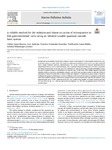A Reliable Method for the Isolation and Characterization of Microplastics in Fish Gastrointestinal Tracts Using an Infrared Tunable Quantum Cascade Laser System

Use this link to cite
http://hdl.handle.net/2183/31561Collections
- Investigación (FCIE) [1227]
Metadata
Show full item recordTitle
A Reliable Method for the Isolation and Characterization of Microplastics in Fish Gastrointestinal Tracts Using an Infrared Tunable Quantum Cascade Laser SystemAuthor(s)
Date
2022-03-26Citation
López-Rosales, A., Andrade, J., Fernández-González, V., López-Mahía, P., Muniategui-Lorenzo, S., 2022. A reliable method for the isolation and characterization of microplastics in fish gastrointestinal tracts using an infrared tunable quantum cascade laser system. Marine Pollution Bulletin 178, 113591. https://doi.org/10.1016/j.marpolbul.2022.113591
Abstract
[Abstract] Societal and environmental concern due to frequent reports of microplastics in fish stomachs raised as they may accumulate along the trophic chain. The request for analysing microplastics in fish stresses two major analytical issues: sample treatment and final characterization. The, so far, workhorse for chemical characterization is infrared spectroscopy which is time-consuming. Here, a quantum cascade laser-based device is used to accelerate the characterization stage. Its novelty poses new challenges for sample processing and particle handling because the unknown particles must be transferred to a reflective slide. In this study, three sample digestion protocols (alkaline-oxidative with H2O2, and alkaline-oxidative with NaClO and enzymatic-oxidative) and three different procedures to transfer the filter cake to reflective slides are compared. A simplified enzymatic-oxidative digestion (validated through an interlaboratory exercise) combined with a Syncore® automatic evaporation system and a Laser Direct Infrared Imaging (LDIR) device is proposed first time as a reliable and relatively fast method to treat gastrointestinal tracts of fish. Analytical recoveries were studied using samples of Scomber scombrus and they were ca. 100% for big –i.e., >500 μm- and ca. 90% for medium –i.e., 200–300 μm- particles and ca. 75% for 10 μm thick fibres.
Keywords
Microplastics
Quantum cascade laser
LDIR
Fish gastrointestinal tract
Automatic evaporation
Enzymatic-oxidative digestion
Quantum cascade laser
LDIR
Fish gastrointestinal tract
Automatic evaporation
Enzymatic-oxidative digestion
Editor version
Rights
Atribución 4.0 Internacional
ISSN
0025-326X






